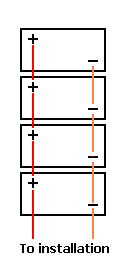Sorry but I am not being harsh, just direct.  Ask questions.
Ask questions.
Most certainly that was my point. With 4 panels in series your Vmp now goes up to 70 volts @ 7 amps. That will result in .88 volt drop or a 1.2% power loss. Target is 2% or less. !4 AWG meets the objective.
Have you bought the batteries yet? If not you really need different plan. Parallel batteries are a horrible plan full of regrets, countless hours of trouble shooting, premature battery failures, battery replacements, and will cause great pain in the wallet. You want one single string if possible and it is always possible. There is no reason for parallel batteries. You just gotta get out of that 12 volt box your mind is trapped in.
It also appears you might be walking into another trap, an expensive one. There are limits to panel wattage, battery size, and inverter load sizes. Get them out of acceptable limits and you will have a failure, an expensive one. With 800 watts of panel power, MPPT Controller, your battery capacity is limited to 24 volts at 260 to 400 Amp Hours. That limits your inverter size to 800 to 1200 watts max.
 Ask questions.
Ask questions.Most certainly that was my point. With 4 panels in series your Vmp now goes up to 70 volts @ 7 amps. That will result in .88 volt drop or a 1.2% power loss. Target is 2% or less. !4 AWG meets the objective.
Have you bought the batteries yet? If not you really need different plan. Parallel batteries are a horrible plan full of regrets, countless hours of trouble shooting, premature battery failures, battery replacements, and will cause great pain in the wallet. You want one single string if possible and it is always possible. There is no reason for parallel batteries. You just gotta get out of that 12 volt box your mind is trapped in.

It also appears you might be walking into another trap, an expensive one. There are limits to panel wattage, battery size, and inverter load sizes. Get them out of acceptable limits and you will have a failure, an expensive one. With 800 watts of panel power, MPPT Controller, your battery capacity is limited to 24 volts at 260 to 400 Amp Hours. That limits your inverter size to 800 to 1200 watts max.

Comment